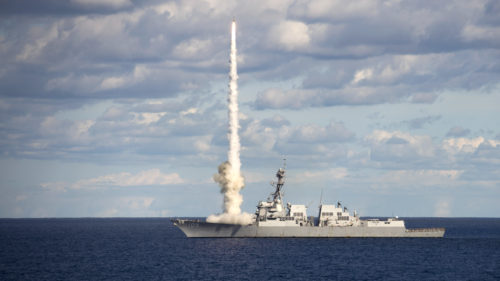Lockheed Martin is gearing up for a live-fire test in the coming months, aiming to showcase the integration of a proven U.S. Army air defense missile with the Navy’s established combat system for its surface fleet. This ambitious project, reported by Breaking Defense, involves integrating the PAC-3 Missile Segment Enhancement (PAC-3 MSE) with the Aegis Weapon System, potentially bolstering the Navy’s air defense capabilities.

ATLANTIC OCEAN (Nov. 1, 2017) The guided-missile destroyer USS Jason Dunham (DDG 109) launches a SM-2 missile during a live-fire exercise. Jason Dunham is underway with the Harry S. Truman Carrier Strike Group preparing for future operations. (U.S. Navy photo by Mass Communication Specialist 3rd Zachary Van Nuys/Released)
The PAC-3 boasts a nearly 30-year history with the Army, undergoing continuous upgrades culminating in the PAC-3 MSE variant. This missile currently defends ground forces against various threats like tactical ballistic missiles, cruise missiles, and aircraft. Lockheed Martin’s vice president, Thomas Copeman, highlighted the program’s robust production line, currently churning out 500 missiles annually and expected to reach 550 by year-end 2024.
On the Navy side, the Aegis Weapon System, primarily built by Lockheed Martin, serves as the command and control center for a ship’s entire arsenal. The impetus for this integration, according to Copeman, began in 2017 through a separate Missile Defense Agency effort. However, Lockheed’s testing so far has been largely funded internally.
Copeman emphasizes the potential advantages for the Navy. He argues that the PAC-3 MSE overlaps with missions currently handled by the Raytheon-made Standard Missile-6 (SM-6). By supplementing the Navy’s inventory with PAC-3, it could free up the SM-6 inventory for “offensive measures” beyond PAC-3’s capabilities.
The Navy has confirmed participation in the upcoming live-fire test and will conduct its own independent performance analysis. While not fulfilling a specific requirement, the Navy spokesperson acknowledges the PAC-3 MSE’s potential to complement the existing Vertical Launch System (VLS) inventory, offering greater missile diversity and expanding production opportunities.
Furthermore, the spokesperson recognizes the PAC-3 MSE’s existing role in defending U.S. and allied assets against diverse threats. They also see it as a potential weapon against advanced anti-ship weaponry.
A successful live-fire test would validate the integration of the PAC-3 MSE using the Mk-41 VLS, one of the launchers used by the Aegis system. If this integration progresses and a deal is struck, Lockheed Martin would add the Navy to its already sizable customer base for the PAC-3 MSE, which includes countries like Germany, Japan, and South Korea.
For more information, hit the Source below